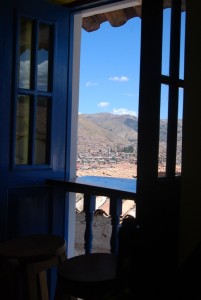La Caverne del Oriente, A French Restaurant in San Blas

Cuzco holds many surprises. One of them are the many exotic, ethnic corners found in the old city. Many have little to do with the history of mass immigration to Peru, unlike ethnic enclaves elsewhere, but rather with the origins of tourists and the development of places for them and their culture that are neither exactly like their homeland nor really Peruvian. These corners of difference live somewhere in between.
La Caverne del Oriente, a charming French fusion restaurant is one of these.
Its name blends French with Spanish and throws in a dash of orientalism for spice. It is as if Ali Baba were going to pop up in Cuzco and offer food based on French traditions with local Andean ingredients.
This is an odd assemblage that seems to work well in a tourist city. There the mystique of the Orient hybridizes with the mystique of Perou which has a long attraction in the world of Francophonie just as France has long held for Peru.
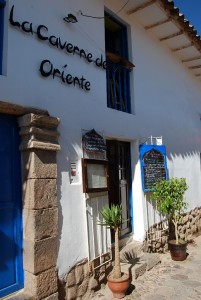
Peru’s great novelist, the Nobel Prize winning Vargas Llosa has been having fun exploring the depths of Peru in France.

He does this in his The Way to Paradise about the exoticist painter Paul Gauguin and his French-Peruvian grandmother, the socialist feminist Flora Tristan.
He follows that with his The Bad Girl: A Novel of a Peruvian living in a French world involved with the perfect image of a sexy, capricious and powerful woman from Peru like the Peruvivian femme in Offenbach’s well known French opera, La Perichole.
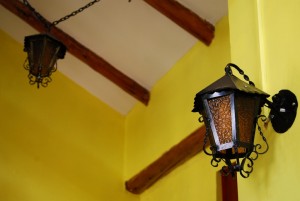
In the case of the restaurant, Greg and Aurea, its owners, are changing Vargas’ Llosa’s direction by building a bit of romantic France in an Peruvian world.
Situated in Cuzco, the cave in the restaurant’s name refers not only to the wonders of the Arab mystique in France with its Ali Baba, it also is a translation of Aurea’s last name, and an intriguing reference to the cave from which the original Incas came forth, known as Pacariqtambo, the place of dawn.
Originally, La Caverne del Oriente was located on a lost corner of the Plaza de San Blas to the left side of the fountain. One entered a dark path by the kitchen before the small restaurant opened before you.
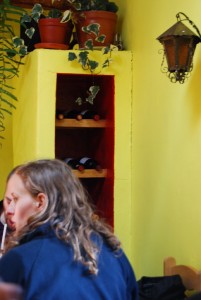
Now they are on Tandapata street, which runs above San Blas Fountain, as if the top line of the Greek letter pi with all its mysterious meaning as something whose division finds no repetition and no end.
Tandapata is white and airy, narrow and yet sunny, as if somehow transported from the Turkish Mediterranean. All kinds of passers by and locals throng the area near the fountain; many and set out their jewelry and other wares on cloths like magic carpets to transport people into the world of mystery and fantasy.
To the left of the rugs and mysterious vendors, in a bright whitewashed building a doorway opens between two bright-green potted plants. The brown, half windowed door opens onto the mysterious world of a kitchen and counter with a stairway to its side.
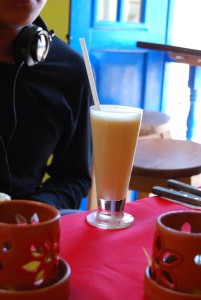
Once up stairs, a lemony-yellow world opens, as if one had ascended to the Arabic realm of lemons and hummus with Spanish colonial finishings.
But instead, beneath the wine rack on the wall, one is given a menu with a range of French fusion cuisine, as well as a daily set price meal.
The day we entered two blond women were just coming out the door and said, in French inflected English, “the food is very good.”
We climbed up and in the bright room, overlooking Cuzco’s orange-tiled roofs, we heard lots of French from a group of tourists who had just gone up themselves.
We ordered the menu, the daily fixed meal.
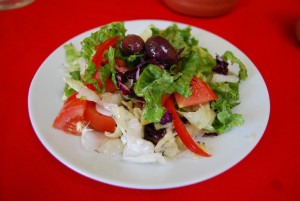
For the first course Hebert chose a green mediterranean salad. It was unusually well dressed in a light vinaigrette that perfectly coated and enhanced each crispy leaf of green lettuce and the other ingredients. That simple salad would easily have been the star of the meal at any other restaurant, given the precision and care with which it was assembled.
Walter and I decided to go further into the oriental cave. We ordered what was described as a quinoa tabbouleh. What a combination! Andean quinoa and a classic salad from the Levant!
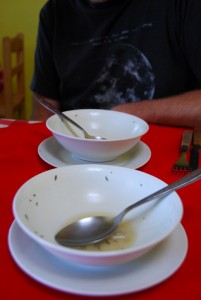
In this case, though the salad was tasty and whet the appetite beautifully, it was more a quinoa salad with pieces of perfectly equally diced parsley and tomato throughout it, rather than the proper parsley salad. The change to quinoa from bulgur wheat was fine, there was just too much of it and it overwhelmed the parsley.
The next course was a light onion soup, that had perhaps a tad too much fresh thyme scattered on it but other wise was very good. This was not the darker onion soup with bread and cheese of so much fame, nevertheless it was well prepared and tasty. Each bowl came with a bay leaf as, not only an herb to flavor the bowl, but a bit of color and a reminder that they used fresh herbs.
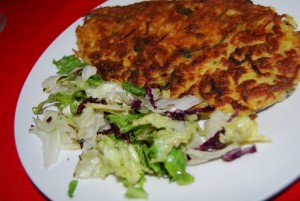
For the main course, Hebert chose a vegetable Spanish tortilla (omelette). It came out of the pan nicely browned on either side and yet nicely cooked inside. It flavor was refreshing and yet had depth, as if one were in Granada in a cafe at the foot of the Alhambra.
Walter and I had a different fusion of the imagination and of food. We chose a flammekueche, that pizza like flat bread with toppings from where France encounters a different border, Alsace/Elsass, a territory which Germany and France fought over for centuries.
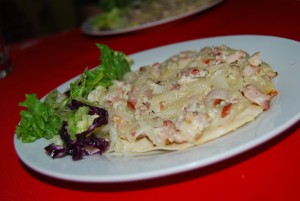
The small hand thrown and thin round bread came out with a topping of lardons and onions in a cheese and white cream sauce. While the flat bread seemed just a tad undercooked, the topping was so delicious we quickly forgot. It was so good that, though satisfying, left us wanting more.
Fortunately, the fixed meal came with dessert.
Walter and Hebert ordered a fresh fruit salad that had a light sauce built on a base of white wine, I believe.
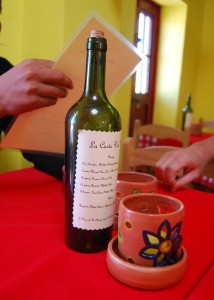
I on the other hand ordered a chocolate torte (pastel de chocolate.) This slice of dark torte with a cross tracing of custard sauce on it was simply one of the best tortes I have ever had. It tasted of good chocolate that lasted well after each nibble, chased by traces of the custard.
I would return to la Caverne just for the fantasy of that torte.
On this visit we did not choose any dishes from their main menu, but if the set meal is any indication, La Caverne del Oriente not only offers an amazingly fused fantasy of Peru and the Orient from a French base, it also offers good food built on French cuisine.
